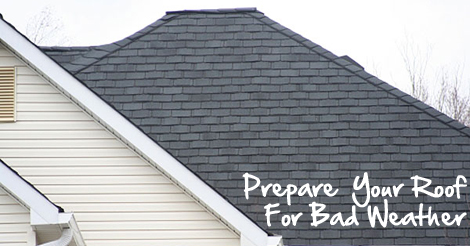Despite the unseasonably warm weather of late, winter is inevitably on its way. With the colder months come storms that can bring damaging snow, sleet, hail. To boot, year-round we are faced with nasty weather that can bring heavy rains and damaging winds down on our homes. Luckily, our homes have roofs, our primary source of protection against the elements. But your roof can only do its job if you care for it properly. Here, we discuss the common types of natural phenomena that can cause roofing damage. We’ll also discuss how you can prepare your roof for bad weather and what you do to prevent or correct problems in a storm’s aftermath.
 Heavy Rain
Heavy Rain
Rain, in and of itself, doesn’t present a problem. Roofs that are in good shape can easily shed even the heaviest of rains without leaking. However, heavy rains can nonetheless become a problem if preventative measures aren’t taken to prevent leaks and other disasters. Be sure to examine your roof several times a year for signs of a problem. You’re looking for decaying or missing shingles or other types of visible damage to the roof. You’ll also want to get up into your attic and inspect the roof from the underside as well. You may be able to spot a leak that in its very early stages by taking this preventative measure.
Unfortunately, too often, homeowners don’t realize there’s damage to their roofs until the ceiling starts leaking during a heavy rain! If you do spot a leak of any kind, place a bucket directly beneath it as a stopgap measure, then contact your roofing company to discuss what can be done.
Another problem that can wreak havoc on your roof’s ability to slough off water is a clogged gutter system. When gutters are stuffed full of leaves and other debris, they can’t do their jobs, which involves collecting water that runs off your roof and safely distributing it away from your home and its foundation. When this happens, it can cause a couple of problems. First, it can cause water to pool up on the roof, which could result in a roof leak. Second, it could cause water to simply run right off your roof’s edge, which means it will collect around your homes’ foundation and even affecting the grading of the area. When this happens, your basement is at risk for flooding. Yikes!
To keep your home dry, make sure you clean out your gutters at least a couple of times a year (in the spring and the fall) to keep them running smoothly.
Snowstorms
Can too much snow cause your roof to fail? Unfortunately, there’s no quick and easy answer to this question, since the probability of a roof collapsing under the weight of snow is dependent on many factors. What comes into to play? The size, shape, and pitch of a roof and whether it’s sheltered by nearby trees are all factors. In addition, the strength of the roof materials and the depth and density of the snow itself, as well as whether it’s spread evenly over the roof or is accumulating in drifts, are also going to affect your roof’s ability to bear the weight of a snowstorm.
So, what can you do to head off a roofing disaster? Inspect the underside of your roof for signs that the rafters are bending or splitting, and be on the lookout for rotted decking. If you notice a problem, call a roofer and/or a structural engineer right away to discuss what can be done.
Once a heavy snow has fallen, be sure to clear at least some of it from your roof using a roof rake. If you can’t safely do this task, you can hire a pro to do it for you.
Strong Winds
Winds can cause damage to your roof in a couple of ways. The first is that it can cause tree branches, large limbs, or even whole trees to land on your roof, which can cause serious damage. By trimming away branches from your roofline, you can reduce the chances that your roof will be damaged by flying or falling debris. Be sure to remove any debris that does fall on your roof and inspect the shingles, as well as the underside of the roof, for visible damage.
The second way wind can wreak havoc on your home’s roof is by tearing the shingles right off, which leaves the roof decking exposed and vulnerable. Sometimes, a missing shingle or two can be replaced, so be sure to inspect your roof after a particularly windy day and address any problems immediately.
Know Who Can Help
There’s no doubt about it—bad weather can really damage your roof. By taking the above steps, though, you can dramatically reduce the chances that your home’s roof will fall victim to Mother Nature’s wrath.
Have a roofing problem or question? Give us a call today at 973-927-0963! George J Keller & Sons have in the roofing business for over 35 years, so we know a thing or two about roofs! Contact us today for a free consultation!
